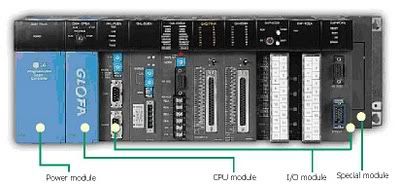PLC banyak digunakan pada aplikasi-aplikasi industri, misalnya pada proses pengepakan, penanganan bahan, perakitan otomatis dan lain sebagainya. Dengan kata lain, hampir semua aplikasi yang memerlukan kontrol listrik atau elektronik membutuhkan PLC.
Dengan kata lain, semakin kompleks proses yang harus ditangani, semakin penting penggunaan PLC untuk mempermudah proses-proses tersebut (dan sekaligus menggantikan beberapa alat konvensional). Selain itu sistem kontrol proses konvensional memiliki beberapa kelemahan dibanding dengan PLC, antara lain:
- Perlu kerja keras saat dilakukan pengkabelan.
- Kesulitan saat dilakukan penggantian dan/atau perubahan.
- Kesulitan saat dilakukan pelacakan kesalahan.
- Saat terjadi masalah, butuh waktu lama.
- Dibandingkan dengan sistem kontrol proses konvensional, jumlah kabel yang dibutuhkan bisa berkurang hingga 80%.
- PLC mengkonsumsi daya lebih rendah dibandingkan dengan sistem kontrol proses konvesional (berbasis relai/kontaktor).
- Fungsi diagnostik pada sebuah kontroler PLC membolehkan pendeteksian kesalahan yang mudah dan cepat.
- Perubahan pada urutan operasional atau proses atau aplikasi dapat dilakukan dengan mudah, hanya dengan melakukan perubahan atau penggantian program, baik melalui terminal konsol maupun komputer PC.
- Tidak membutuhkan spare part yang banyak.
- Lebih murah dibandingkan dengan sistem konvensional, khususnya dalam kasus penggunaan instrumen I/O yang cukup banyak dan fungsi operasional prosesnya cukup kompleks.
- Ketahanan PLC jauh lebih baik dibandingkan dengan relai auto-mekanik.
ENGLISH VERSION
Know PLC
PLC (Programmable Logic Controller) is a tool used to replace a series of several relays are found in the conventional process control systems. PLC works by reading the input (via associated sensors), then do the process and act as we want, which is a turn on or turn off or turn on the output (logic 0 or 1 .) Users create a program in accordance with what was planned (which is generally called a ladder diagram or ladder diagram) which is then stored and executed by the PLC concerned. In other words, the PLC determines what action should be performed on the instrument output related to the status of any size or quantity that is observed.
PLC is widely used in industrial applications, eg in the process of packing, material handling, automated assembly and so forth. In other words, almost all applications that require electrical or electronic control requires PLC.
In other words, the more complex process that must be addressed, the more important the use of PLC to facilitate these processes (and also replace some conventional equipment). Besides the conventional process control systems have some disadvantages compared with the PLC, among others:
- Need to work hard when I do the wiring.
- Difficulties when do the replacement and / or changes.
- The difficulty now is tracking error.
- When there are problems, take a long time.
While the use of the PLC controller has several advantages compared with conventional control systems, among others:
- Compared with the conventional process control systems, the number of cables required can be reduced by 80%.
- PLC lower energy consumption compared with conventional process control system (based relays / contactors).
- Diagnostic functions in a PLC controller allows the detection of errors that easily and quickly.
- Changes to the operational sequence or a process or application can be done easily, simply by changing or replacing the program, either through console or computer terminal PC.
- Does not require a lot of spare parts.
- It's cheaper than conventional systems, particularly in the case of the use of the instrument I / O is quite a lot and operational functions of the process is quite complex.
- Resilience PLC is much better than the auto-mechanical relays.





